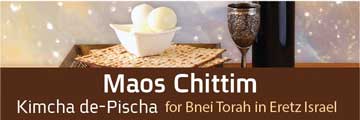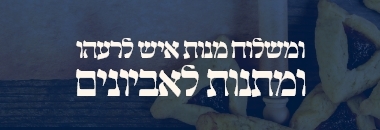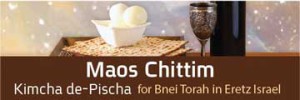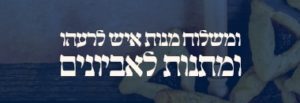Halachah Talk
Zecher LeMachatzis HaShekel
The minhag of giving coins in remembrance of the machatzis hashekel given during the time of the Beis Hamikdash is a very ancient and cherished custom, and is based on a mitzvah min haTorah. Additionally, as we will discuss later, Chazal tell us that it was in the merit of the mitzvah of machatzis hashekel that we were saved from Haman’s plot (Megillah 13b). With the approach of Purim, let us therefore examine the original mitzvah of machatzis hashekel and how its “zecher” is practiced today.
Mitzvah min haTorah
In Parshas Shekalim which we read every year in anticipation of the month of Adar, the Torah states: “This is what they shall give – everyone who passes among the counted – half of the shekel, by the holy shekel, the shekel is twenty geirah, half of the shekel as a terumah (portion) to Hashem. Everyone who passes among the counted, from the age of twenty years and up, shall give the terumah of Hashem. The wealthy shall not increase and the destitute shall not decrease from half of the shekel – to give the terumah of Hashem, to atone for your souls” (Shemos 30:13-15).
Rashi (30:14, s.v., lechapeir) explains that each mention of the word “terumah” is actually referring to a different donation to the Mishkan:
1) Terumas Adanim – this silver was set aside to use in making the adanim, the socketed bases which were the supports for the kerashim, the planks that made up the walls of Mishkan.
2) Terumas Shekalim – these funds were used to purchase the public korbanos offered in the Mishkan, and subsequently in the Beis Hamikdash.
3) Terumas Hamishkan – which consisted of all of the donated materials used in the construction of the Mishkan.
Based on this pasuk, most Rishonim write that it is a mitzvas asei d’Oraisa to give a half shekel every year to the Beis Hamikdash (Rambam, Hilchos Shekalim 1:1; Chinuch #105).
The Zecher: Early Sources
As we mentioned, the minhag of giving coins zecher lemachatzis hashekel is very ancient. The earliest source of this custom is Meseches Sofrim (21:4) which states: “On the first of Adar they would make announcements concerning the shekalim… And all Jews must give their shekalim before Shabbos Zachor. One is not allowed to say concerning them [that they are being brought] for the sake of atonement, but rather as a donation. These [coins] are used to supply water and food for their poor brethren.”
The requirement of not saying that the coins are for the sake of atonement (kaparah) refers to the idea that the machatzis hashekel money achieved atonement for the Jewish people, as it was used to purchase public korbanos that were offered on the altar (see Rashi, Shemos 30:14, s.v., lechapeir). By emphasizing the fact that one should not say that the money was for atonement, we indicate that this money is not for the real “machatzis hashekel” used for korbanos, but rather it is merely a donation to be used for tzedakah purposes. We will see later that several authorities prohibited giving money zecher lemachatzis hashekel out of concern that people would give it as machatzis hashekel and it would become dedicated to the Beis Hamikdash and forbidden to use.
In Meseches Sofrim that I quoted above and in the writings of the Gaonim, we do not find any details concerning the procedure for giving the zecher lemachatzis hashekel. Only later in the writings of the Ashkenazi Rishonim do we find the minhag of giving three “half-coins” or coins that are half of the value of the local monetary unit (Rokei’ach al HaTorah, Parshas Ki Sisa; Minhagei Maharam MiRotenberg; Mordechai, Megillah #777).
The minhag of giving money zecher lemachatzis hashekel, although cited in the seforim that recorded Minhagei Ashkenaz, is not mentioned by the Tur, Beis Yosef or Shulchan Aruch. Rather, the first of the poskim to mention this custom is the Rama, who writes: “The custom is to give tzedakah before Purim as a remembrance of the machatzis hashekel. We give a coin which is half of another coin (Rama, 694:1).
Reason for the Minhag
We find in the words of Chazal and the Rishonim several reasons for the minhag of giving money zecher lemachatzis hashekel. These include:
1) In Meseches Sofrim that we quoted earlier, Chazal write: “On the first of Adar they would make announcements concerning the shekalim. And why on the first of Adar? Because it was foreseen, known and revealed before the One Who Spoke and the world came into existence, that the wicked Haman would eventually come and weigh [ten thousand silver] talents (see Esther 3:9) concerning the Jews. Therefore, [Hashem] preempted him and said to Moshe that the shekalim of Yisrael should come before the shekalim of Haman.”
From this statement we understand that the whole concept of giving machatzis hashekel during the time of the Beis Hamikdash and zecher lemachatzis hashekel after the churban was preordained by Hashem in order to give Klal Yisrael a zechus through which they would overcome Haman’s plot.
2) In Sefer Leket Tov, a compilation of homiletic explanations of the Chumash authored approximately 800 years ago by Rabbeinu Tuviah, the author notes the fact that in Parshas Shekalim the Torah twice commands that “anyone who passes among the counted” should give a half shekel. He explains this redundancy by saying that the repetition indicates that this mitzvah is “ledoros” – for future generations even after the churban. He writes: “For during the time when the Beis Hamikdash stood, a person would give his shekel and he receive atonement. This is because his shekel would join together with those of all of Yisrael and they would buy with them the Tamidim and other public offerings. Now that the Beis Hamikdash is no longer standing, a person is obligated to give gifts to the poor, as it is written, “and sending delicacies one to another and gifts to the poor” (Esther 9:22). And not only should one give on Purim, but even the rest of the year, when a pauper needing money comes to you, you are obligated to give him.”
Although this explanation does not speak specifically of our custom to give money zecher lemachatzis hashekel, however it makes a direct connection between the atonement attained through machatzis hashekel and that of the general mitzvah of giving to the poor in our days.
Opposing the Minhag
We find in the responsa of the Gaonim that there were several communities that had the custom of giving half shekalim in anticipation of Purim and the money was distributed among the poor. Several of the Gaonim opposed this minhag, as it was common for the people to refer to the donated money as “shekalim.” The Gaonim were concerned that by calling it such, there was worry that perhaps those donating this money had the original shekalim in mind. This would prohibit the use of this money for anything aside the purchase of korbanos and other shekalim-related activities (Seder Rav Amram Gaon, Hilchos Purim; Teshuvos Gaonei Mizrach u’Maariv #40).
On the other hand, those that were in favor of the minhag contended that as long as those giving the money did not say that they were doing so for atonement but rather as a donation, there is no concern that the money would become hekdesh. This is based on the statement to that effect in Meseches Sofrim that we quoted earlier.
In deference to the opinion of the Gaonim mentioned above, one should be careful not to say he is giving the money for machatzis hashekel (Nitei Gavriel, Purim, chapter #26).
The Proper Time
Although Meseches Sofrim states that half shekalim are given “before Shabbos Zachor,” the Rama writes (694:1) that it is given on “Purim eve before Mincha,” which in most years is Taanis Esther afternoon. Various reasons have been suggested why we give the coins on Taanis Esther and no longer follow the opinion of Meseches Sofrim. These include:
1) In order to perform the minhag “berov am” – together with a large group of people, since this is the time when people gather for megillah leining. This also insures that people will not forget to do so (Taamei Haminhagim #871).
2) The Gemara (Brachos 6b) states that the “reward of the fast is tzedakah.” In other words, it is appropriate to give tzedakah on a fast day. This is one of the considerations of those communities who give the zecher lemachatzis hashekel on Taanis Esther.
The Rama’s opinion not withstanding, there are many minhagim as to when the zecher lemachatzis hashekel is given. These include:
1) Some contend that the half shekalim should be given prior to tefillas Mincha when davening after the time Mincha Katanah in the late afternoon of the thirteenth of Adar, and not at Mincha Gedolah. This is based on the opinion of the Rama that the money is given on “Leil Purim” – Purim Eve (Shu”t Rivevos Ephraim, volume II, #194). Indeed, this was the practice of the Steipler, that although he davened at Mincha Gedolah, he would give the coins zecher lemachatzis hashekel before Maariv (Orchos Rabbeinu #61).
2) Some communities have a custom to give the half shekalim after Mincha in order that it is closer to “Purim Eve” (Luach Eretz Yisrael; Siddur Yaavetz).
3) The custom practiced in the ancient German community of Vermaisa (Worms) was to announce that everyone should come to the shul three hours after chatzos on Erev Purim and everyone would give the coins zecher lemachatzis hashekel at that time (Minhagei Vermeisa, page #255).
4) The Kitzur Shulchan Aruch (141:5) writes that the custom is to give zecher lemachatzis hashekel before krias Megillah on Leil Purim.
5) On the other hand, the Magen Avraham (694:2) writes that the custom in his community is to give these coins before the morning megillah leining.
Someone who forgot to give zecher lemachatzis hashekel before Purim can still fulfill the mitzvah anytime during the month of Adar. Additionally, if one forgot to give the money during one particular year, he can still give it during Adar of the following year (Shu”t Avnei Yashphe #133; Orchos Chaim 694:2).
Purim on Motzai Shabbos
When Purim occurs on Motzai Shabbos as it does this year (5771), when is the correct time to give the money zecher lemachatzis hashekel? On the one hand, as we mentioned, an important facet of a fast day is the mitzvah of giving tzedakah, and therefore one should perform the minhag on Taanis Esther which is moved up to Thursday. However, some argue that since some Rishonim refer to the zecher lemachatzis hashekel money as “ma’os Purim” – Purim money, it is proper to give this money as close to Purim as possible, if not on Purim itself.
Most are of the opinion that due to the importance of giving tzedakah on a fast, the coins are given on Taanis Esther, even though it is still several days before Purim (Minhagei Vermaisa; Kaf Hachayim 694:25).
There is a minority view that because of the doubt as to when to give the zecher lemachatzis hashekel, one should give it both on Taanis Esther and on Purim itself (Shu”t Divrei Yatziv [Klausenberger Rebbe] volume II #293; Darchei Chaim Veshalom [Minchas Elazar of Munkatch] #843).
It is interesting to note that in Yerushalayim where the megillah is read on the fifteenth of Adar, there are also divergent customs concerning the best time to give zecher lemachatzis hashekel. Some maintain to follow the general practice of doing so on Taanis Esther, while others prefer the fourteenth in the late afternoon immediately before krias megillah.
Who is Obligated?
The custom of giving zecher lemachatzis hashekel pertains to all Jewish men. There is a disagreement among the Rishonim and Acharonim concerning at what age this obligation begins. Although the original argument revolved around the Torah obligation of machatzis hashekel that was applicable as long as there was a Beis Hamikdash, many facets of our custom to give zecher lemachatzis hashekel are derived from the mitzvah min haTorah.
According to the Sefer Hachinuch (#105) and Rabbeinu Ovadiah MiBartenura (Shekalim 1:3), the Torah mitzvah is only incumbent on twenty year olds and older. On the other hand, the Rambam (Hilchos Shekalim 1:7), the Ramban (Shemos 30:12) and the Tosafos Yom Tov (Shekalim 1:3) all contend that the Torah mitzvah begins from the time a person becomes bar mitzvah.
The Rama (694:1) writes that one is not obligated to give zecher lemachatzis hashekel until he is twenty. However, the later authorities maintain that most poskim contend that even thirteen year olds should fulfill the minhag of zecher lemachatzis hashekel (Aruch Hashulchan 694:8; Mishnah Berurah 694:5).
Although technically speaking, a child under the age of bar mitzvah is exempt from zecher lemachatzis hashekel, the minhag is that the father gives these coins on behalf of his underage sons. The reason for this is based on the idea that the Torah states that machatzis hashekel is “to atone for your souls” (Shemos 30:16). Therefore, the custom developed to give on behalf of minors so that they can also have atonement (Levush 686:2; Siddur Yaavetz; Kaf Hachayim 694:27).
It is a Vow
Another facet of zecher lemachatzis hashekel derived from the original mitzvah concerns the aforementioned minhag of giving on behalf of minors. The Mishnah in Shekalim (1:3) states that if a father begins giving machatzis hashekel on behalf of his underage child, he is not allowed to stop. This is because the practice has the status of a vow and the father is obligated to continue. The same applies to the custom of zecher lemachatzis hashekel. Once the father begins giving money for his son, he must continue to do so until the child becomes bar mitzvah and does so on his own (Kaf Hachayim 694:28; Mishnah Berurah 694:5).
Women and Girls
Concerning whether women and girls should give money zecher lemachatzis hashekel has been a matter of debate starting with the Rishonim and continuing until the contemporary poskim. Some maintain that since during the time of the Beis Hamikdash they were exempt from giving machatzis hashekel, they are similarly not required to give zecher lemachatzis hashekel (Rambam, Hilchos Shekalim 1:7; Aruch Hashulchan 694:8; Orchos Rabbeinu, volume III, page 52).
Others contend that since had they donated the machatzis hashekel during the time of the Beis Hamikdash, it would have been accepted, they can certainly give zecher lemachatzis hashekel (Magen Avraham 694:3 in the name of Hagahos Maimonios; Leket Yosher page 157; Kaf Hachayim 694:27; Shu”t Shevet Halevi, volume VII, #183).
The Amount
The Rama writes (694:1) that the minhag is to give “half of the local monetary unit in use at that time.” For example, in theUnited States, where the currency is the Dollar, one should give a half dollar, or inIsrael where the currency is the New Israeli Shekel (NIS), one gives a halfNIS.
Additionally, the Rama writes that since the word “terumah” appears three times in the parshah of machatzis hashekel, the minhag is give the above mentioned amount three times. Using our previous examples, this would amount to $1.50 or 1.50NIS.
There is discussion among the poskim concerning the Rama’s intention in describing this minhag. Some maintain that the minhag is to give a specific coin that is called a “half” in relation to the local currency (a half-dollar or a half-NIS). Others contend that it is sufficient to give the amount equal to half of the local currency. For example, if the half dollar piece would not exist, according to this view one would fulfill the minhag by giving 50 cents (Kaf Hachaim 694:20; Yesod Veshoresh Ha’avodah 12:3; Shu”t Minchas Yitzchak 9:69; Shu”t Teshuvos Vehanhagos 1:400).
Since half dollars are not common anymore, in many shuls it is customary for the gabay to put three half dollars in the tzedakah box. Each person puts in $1.50, picks up the three half dollars as an act of acquisition, and then donates them to the zecher lemachatzis hashekel fund.
No Coins Available
What does one do in a country that does not have “half” coins?
According to the above mentioned view, in this case one should give the equivalent of that amount with other coins (Shu”t Minchas Yitzchak ibid; Shu”t Teshuvos Vehanhagos ibid.). Others suggest that two people can give one unit of the local currency between them and it is considered as if each gave half (Daas Torah 692:4).
The Weight in Silver
According to some opinions, in order to fulfill the minhag of zecher lemachatzis hashekel in the best possible way, one should give the equivalent of the machatzis hashekel that existed during the time of the Beis Hamikdash. This is the equivalent of ten grams of silver, which according to current silver prices, is valued at $9-10. One wishing to follow this stringency does not have to give three times the amount, but rather once is sufficient (Kaf Hachaim 694:100; Shu”t Yechave Daas, volume I, #86).
Let us hope that we will soon merit to bring the real machatzis hashekel to the Beis Hamikdash!










